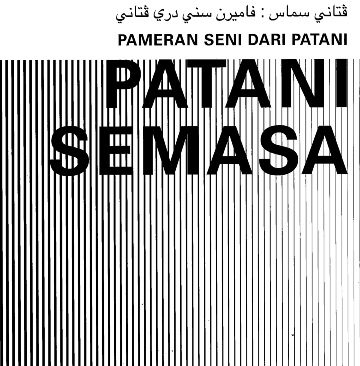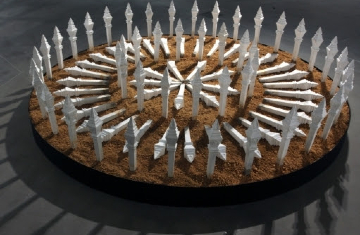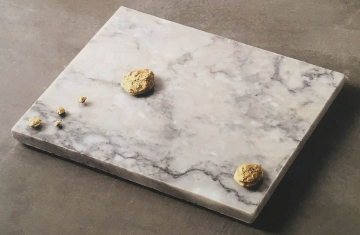



The Patani Semasa (ปาตานี ร่วมสมัย) exhibition, first held at MAIIAM in Chiang Mai in 2017, was shown in Malaysia last year. It was considered too sensitive to publish a catalogue for the Thai exhibition, as several works address state violence in Thailand’s southernmost provinces, and the catalogue was therefore published in Malaysia. It includes an essay by lead curator Gridthiya Gaweewong and full-page reproductions of each artwork, with extended captions. The fold-out cover features a timeline of the region’s political and cultural history.
Apichatpong Weerasethakul’s Photophobia, Jakkhai Siributr’s 78, and Jehabdulloh Jehsorhoh’s Violence in Tak Bai (ความรุนแรงที่ตากใบ) all address the 2004 Tak Bai massacre, a tragedy also commemorated by Zakariya Amataya’s Report from a Partitioned Village (รายงานจากหมู่บ้านที่ถูกปิดล้อม) at the Khonkaen Manifesto (ขอนแก่น แมนิเฟสโต้) exhibition. Ruangsak Anuwatwimon’s No Country Like Home is a reminder of another 2004 massacre, at Krue Se Mosque; like his Hocus Pocus (เผาเล่น ที่จริง) installation, which dealt with the 2010 political violence in Bangkok, it incorporates an artefact bearing the physical scars of the attack.
Apichatpong Weerasethakul’s Photophobia, Jakkhai Siributr’s 78, and Jehabdulloh Jehsorhoh’s Violence in Tak Bai (ความรุนแรงที่ตากใบ) all address the 2004 Tak Bai massacre, a tragedy also commemorated by Zakariya Amataya’s Report from a Partitioned Village (รายงานจากหมู่บ้านที่ถูกปิดล้อม) at the Khonkaen Manifesto (ขอนแก่น แมนิเฟสโต้) exhibition. Ruangsak Anuwatwimon’s No Country Like Home is a reminder of another 2004 massacre, at Krue Se Mosque; like his Hocus Pocus (เผาเล่น ที่จริง) installation, which dealt with the 2010 political violence in Bangkok, it incorporates an artefact bearing the physical scars of the attack.
